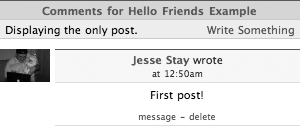Name
<fb:comments/>
Similar to the <fb:board/> tag (described earlier in this chapter), this tag creates a Wall-like component that users can comment on. The data for these <fb:comments/> blocks is not available to the developer and is controlled by Facebook. It provides an easy way for your users to make comments.
FBML-Specific Attributes
Required
xid=[string] default: noneThe unique identifier for this comments block. Each post within the series of posting comments will reference this identifier.
canpost=[true|false] default: nonecandelete=[true|false] default: nonenumposts=[int] default: noneThe total number of posts visible when the page loads. The “See All” link allows the user to still see all posts.
Optional
callbackurl=[string] default:the current pageThe URL that Facebook references to identify the source of the current comments block.
returnurl=[string] default:the current pageThe URL to take the user to after the user clicks the “Return” link.
showform=[true|false] default: trueIf
true, shows the form block below the comments on the first page of the comments. The user will not have to click the “See All” link to add a comment this way.send_notification_id=[int] default: noneThe ID of the user to send notifications to when comments are made for the current comment block.
Example FBML
The following example FBML generates a simple comments block for the “Hello Friends” example in Chapter 1 (Figure 3-52 shows the result):
<div style="width:300px">
<fb:comments xid="hello_friends_comments" canpost="true" candelete="false"
returnurl="http://apps.facebook.com/fbmlessentials/">
<fb:title>Comments for Hello Friends Example</fb:title>
</fb:comments>
</div>

